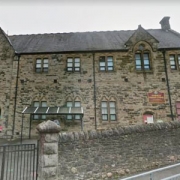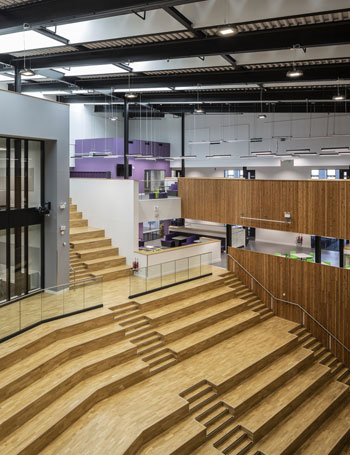This report from the US points to Ventilation as critical in the fight against Covid-19
#ventilation #construction #schoolbuildings #covid-19 #Maintenacemanagers #localauthorities
Every Thursday at 11 a.m., Tulsa’s school facilities director, Sue Ann Bell, appears live on the district’s Facebook page to show parents the extraordinary and very expensive efforts her staff is making to fight off the coronavirus when students return.
In one episode that’s garnered more than 2,000 views, Bell, along with a Spanish-language translator, walks the glistening hallways of Anderson Elementary School, detailing how her staff has repeatedly scrubbed the walls, floors, lockers, and door handles, installed Plexiglas around the front office secretaries’ desks, and placed signage in the hallways urging students to stand six feet apart, wear a mask, and wash their hands.
She then enters the school’s now spaced-out library where a janitor hoses down chairs with BioSpray, a hospital-grade disinfectant known to kill 99.9 percent of bacteria.
“We want to be ready,” Bell says, staring into the camera.
America’s schools are on average more than 44 years old, aging buildings that can host thriving colonies of bacteria, lead, and mold. Kids are often taught in classrooms that are either freezing cold or burning hot. Flu outbreaks are frequent.
Now, administrators are being asked to fight off the coronavirus, which causes COVID-19, a much more contagious and lethal airborne disease than the flu.
Over the last couple of months, directors of school facilities have gotten a crash course on the dynamics of building-air ventilation, personal protective equipment, and effective cleaning chemicals. They’re also wading into public relations work, deployed by their bosses to be the messengers-in-chief on health and safety protocols.
Bell, who manages a sprawling portfolio of real estate, has seen all sorts of things during her 25 years tending to Tulsa’s 82 schools, including tornados, floods, and dust storms. (“You never know what Mother Nature is going to throw at you,” she said.)
See Also: What Needs to Change Inside School Buildings Before They Reopen
But nothing, she said, comes close to the coronavirus. The research keeps evolving, the guidance keeps changing, and parents’ fears keep ramping up.
“I’m working seven days a week trying to prepare for this,” Bell said. “My mind is constantly asking, ‘What are the areas that we’re not thinking about?’ and that’s what keeps me up at night.”
Days before schools were set to open for hybrid learning, Tulsa’s school board voted to keep buildings closed until the local infection rate declines.
Air Ventilation Needs Are ‘Urgent’
The coronavirus, several researchers have concluded, spreads more rapidly in crowded, poorly ventilated areas where there’s heavy breathing or shouting and can stay in the air and on surfaces for several hours.
With students returning to school, even in smaller groups on a part-time basis, experts have raised concerns that school buildings will only exacerbate infection rates.
The hallways are narrow, classroom space is limited, and students, loud and rambunctious, touch everything, including each other. Not all schools are, or will, require students to wear masks, despite compelling evidence that face coverings are one of the best preventions against spread of the virus.
Districts have been required by states to overhaul their cleaning strategies and they’ve pledged to more frequently deep-clean buildings.
Their primary concern, though, is air ventilation.
The U.S. Government Accountability Office said in a report in June that, in order to prevent the spread of the coronavirus, more than 41 percent of school districts need to update or replace their heating, ventilation, and air conditioning systems in at least half their schools.
“The need is urgent,” said Corey Metzger, the chair of the schools team for ASHRAE’s epidemic task force. ASHRAE, a professional group for heating, refrigerating, and air-conditioning engineers, has put out guidance for schools to prepare for the coronavirus.
Metzger runs an engineering consulting firm in Ames, Iowa, that designs schools and helps school administrators keep their buildings up to code. This summer, he said, several districts have asked his team to help upgrade ventilation systems, a process that can run anywhere between 50 cents to $50 a square foot. Others see the price tag, gawk, and decide to open up their poorly ventilated schools anyway.
Cash for Facilities Is Scarce
All the readying it takes to reopen school buildings comes at a steep price many districts can ill afford.
Spending on facilities is one of the most inequitable and insufficiently funded corners of school finance.
A study in 2016 showed that the average school needs more than $4.5 million worth of repairs. Because more than 80 percent of capital costs are funded locally, whether a district has money to upgrade a building depends mostly on whether the surrounding taxpayers think it’s a good idea.
With districts facing sizeable budget cuts in the coming months, many administrators have either frozen or cut their school building maintenance costs, a less noticeable measure than teacher layoffs.
In 2015, voters in Tulsa passed a $415 million bond for the district, which serves a student population that is more than 80 percent low-income and 59 percent Black and Latino. A panel that monitors the spending of that bond this summer expanded its rules to allow for administrators to upgrade several of their schools’ ventilation systems, which cost the district around $2.7 million.
The district this summer also purchased 148 static sprayers, each costing $1,500 each, and $650,000 worth of new cleaning supplies, chemicals, and hand sanitizer, said Nolberto Delgadillo, the district’s chief financial officer. He said he also anticipates having to pay for staff training and possibly overtime hours for maintenance workers.
The district this year has already cut $20 million from its budget and, without an infusion of federal emergency aid from Congress, anticipates more cutting soon.
Communications Is a Big Part of the Job
Bell and the district’s communications department decided to start the Facebook live sessions after hearing concerns among parents that school buildings won’t be safe.
During the sessions, which last around 20 minutes and take place throughout the city, Bell talks to bus drivers, maintenance workers, and HVAC contractors about ways they plan to prevent the spread of the virus.
She opens doors to show cabinets stocked with containers of disinfectant wipes now accessible to teachers, walks through classrooms to show spaced-out desks, and describes all the new chemicals they use to keep buildings germ-free. Throughout the sessions, which have garnered thousands of views, parents pepper her with questions about reopening plans.
“We want families to know that we’re doing things differently this year,” she said.
Source: Education Week






 “The Seismic system is already proving the benefits of offsite construction in the schools sector and our componentised off-site schools solution has saved the country tens of millions. Unsurprisingly, we are gaining interest from many other sectors too, including housing and healthcare. With this additional investment we’re through to a whole new level of productivity, efficiency and materials innovation.
“The Seismic system is already proving the benefits of offsite construction in the schools sector and our componentised off-site schools solution has saved the country tens of millions. Unsurprisingly, we are gaining interest from many other sectors too, including housing and healthcare. With this additional investment we’re through to a whole new level of productivity, efficiency and materials innovation.




